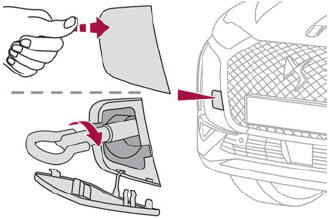DS 3: 12 V battery / Accessory battery / Charging the battery using a battery charger
For optimum service life of the battery, it is essential to maintain an adequate state of charge.
In some circumstances, it may be necessary to charge the battery:
- When using the vehicle mainly for short journeys.
- If the vehicle is to be taken off the road for several weeks.
Consult a dealer or a qualified workshop.
 To
charge the vehicle's battery yourself,
use only a charger compatible with
lead-acid batteries with a nominal voltage of
12 V.
To
charge the vehicle's battery yourself,
use only a charger compatible with
lead-acid batteries with a nominal voltage of
12 V.
 Follow the instructions provided by the
manufacturer of the charger.
Follow the instructions provided by the
manufacturer of the charger.
Never reverse polarities.
 It is
not necessary to disconnect the
battery.
It is
not necessary to disconnect the
battery.
- Switch the ignition off.
- Switch off all electrical consumers (audio system, lighting, wipers, etc.).
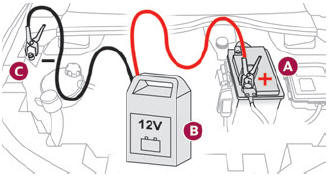
- Switch off charger B before connecting the cables to the battery, so as to avoid any dangerous sparks.
- Ensure that the charger cables are in good condition.
- Lift the plastic cover on the (+) terminal, if the vehicle has one.
- Connect the cables of charger B as follows:
- the positive (+) red cable to the (+) terminal of battery A,
- the negative (-) black cable to earth point C on the vehicle.
- At the end of the charging operation, switch off charger B before disconnecting the cables from battery A.
 If
this label is present, use only a 12 V
charger to avoid causing irreversible
damage to the electrical components.
If
this label is present, use only a 12 V
charger to avoid causing irreversible
damage to the electrical components.
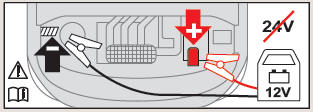
 Never
try to charge a frozen battery - risk
of explosion!
Never
try to charge a frozen battery - risk
of explosion!
If the battery has frozen, have it checked by a dealer or by a qualified workshop who will verify that the internal components have not been damaged and that the case has not cracked, which would mean a risk of toxic and corrosive acid leaking.
 Some
functions, including Stop & Start,
are not available if the battery is not
sufficiently charged.
Some
functions, including Stop & Start,
are not available if the battery is not
sufficiently charged.
Disconnecting the battery
In order to maintain an adequate state of charge for starting the engine, we recommend disconnecting the battery if the vehicle is to be unused for an extended period.
Before disconnecting the battery:
- Close all openings (doors, boot, windows, roof).
- Switch off all electricity-consuming devices (audio system, wipers, lamps, etc.).
- Switch off the ignition and wait for 4 minutes.
After accessing the battery, it is only necessary to disconnect the (+) terminal.
Quick-release terminal clamp
Disconnecting the (+) terminal
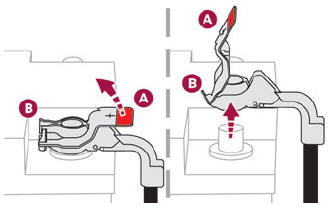
- Depending on equipment, lift the plastic cover on the (+) terminal.
- Raise lever A fully to release clamp B.
- Remove clamp B by lifting it off.
Reconnecting the (+) terminal
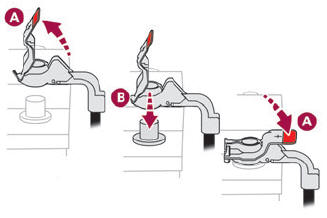
- Raise lever A fully.
- Refit open clamp B on the (+) terminal.
- Push clamp B fully down.
- Lower lever A to lock clamp B.
- Depending on equipment, lower the plastic cover on the (+) terminal.
 Do
not force the lever, as it will not lock in
place if the clamp is not positioned
correctly; start the procedure again.
Do
not force the lever, as it will not lock in
place if the clamp is not positioned
correctly; start the procedure again.
Following reconnection
After reconnecting the battery, turn on the ignition and wait 1 minute before starting the engine, to enable the electronic systems to initialise.
If minor problems nevertheless persist following this operation, contact a dealer or a qualified workshop.
Referring to the relevant section, reinitialise certain equipment:
- Electronic key.
- Electric windows.
- Date and time.
- Preset radio stations.
 After
reconnecting the battery, the
message "Collision risk detection system
fault" is displayed on the instrument panel
when the ignition is switched on. This
operation is perfectly normal. The message
will disappear while driving.
After
reconnecting the battery, the
message "Collision risk detection system
fault" is displayed on the instrument panel
when the ignition is switched on. This
operation is perfectly normal. The message
will disappear while driving.
 The
Stop & Start system may not be
operational during the trip following the
first engine start.
The
Stop & Start system may not be
operational during the trip following the
first engine start.
In this case, the system will only be available again after a continuous period of immobilisation of the vehicle, a period which depends on the exterior temperature and the state of charge of the battery (up to about 8 hours).
 Starting using another battery
Starting using another battery
If the vehicle's battery is flat, the engine can be
started using a backup battery (either external or
from another vehicle) and jump leads or using a
battery booster...
 Towing the vehicle
Towing the vehicle
General recommendations
Observe the legislation in force in the country where you are driving.
Check that the towing vehicle is heavier than the towed vehicle...
Other information:
DS 3 2016-2026 Owners Manual: Messages and alerts
To benefit from the following information on the instrument panel, select the DRIVING or Driving aids display mode. The display of these messages or alerts is not sequential. "Cruise paused" or "Cruise control on hold" following brief acceleration by the driver...
DS 3 2016-2026 Owners Manual: Settings
Configuring profiles Press Settings to display the main page. Press "Profiles". Select "Profile 1", "Profile 2", "Profile 3” or "Common profile". Press this button to enter a name for the profile using the virtual keypad. Press "OK" to save...
Categories
- Manuals Home
- 1st Generation DS 3 Owners Manual
- 1st Generation DS 3 Service Manual
- Trip computer
- Tyre under-inflation detection
- Boot
- New on site
- Most important about car
Towing your vehicle
To access the front screw thread:
